OY VEY! I am so sorry that I’ve sort of “slacked off” on my stretching series. I’ve been sick for the past week and then I just sprained ankle on top of it. Apparently I can dance better than I can walk. 🙂 So while I’m taking a little hiatus from dance and intense stretching to let my body heal from the illness and injury, I figured I’d bring up a topic that seems to be controversial at the moment- can you become TOO flexible or overstretch when it comes to ballet?? I found an article about how the positions of ballet have changed over the years and how they require a different level of flexibility and it raises interesting questions about the pressure it puts on dancers to be crazy flexible. I’ll fess up… one of my guilty pleasures is following a ton of little ballet Instagrams that are likely run by 12 year old girls (not that there’s anything wrong with that, but I’m “old” in comparison so it makes me feel a little silly haha). So my Instagram feed is overrun with pictures of girls doing tilts, oversplits, and various other insane in the membrane stretches.
Part of me is blown away at the awesomeness of the stretches. It’s really amazing to see what the human body is capable of when you stretch it out and push its limits. The other part of me is really curious as to the concerns and dangers associated with stretching to extremes. I am, of course, a huge advocate of stretching as I find it’s very important to keeping a healthy body as well as progressing in ballet. I am also very cautious and try to make sure to weigh the costs with the benefits before I do anything. For me, the biggest concern that I have with these extreme stretches are the dangers involved. Could you imagine if one of the chairs in the above pictures slipped out during the process of getting in this position?! Holy pain, Batman. Or when I see people stretching their arches by sticking their foot under a couch and forcing it down I can’t help but wonder how much potentially “unnecessary” strain they are putting on their joints, tendons, ligaments and muscles that could later lead to serious injury.
When trying to do research on the topic I found some really weird mixed messages. A lot of sources say that you can’t really be too flexible and that you should try and push and push until you can get further. A lot of other sources say that being overly flexible is neither necessary nor helpful in ballet because it actually makes you need to work harder to maintain the classic lines that make ballet seem graceful rather than looking contorted. Although I found a lot of opinions of parents of dancers, adult dancers, and teen dancers, there aren’t a whole lot of easily accessible resources based from more reliable “official” sources. So, because I am no expert and definitely cannot give you advice on the matter, I advise that you weight the pros and cons yourself before attempting any stretches of that magnitude and always recommend caution. But I figured it could be an interesting point of conversation. Do you feel that these extreme forms of stretching can help or hinder ballet? How do you feel about the ever increasing flexibility requirements of ballet and how it changes the way the lines of the body look?
On a more fun note, I also decided to do the ABC survey Kristen posted to tell you a little more about myself after the jump 🙂






